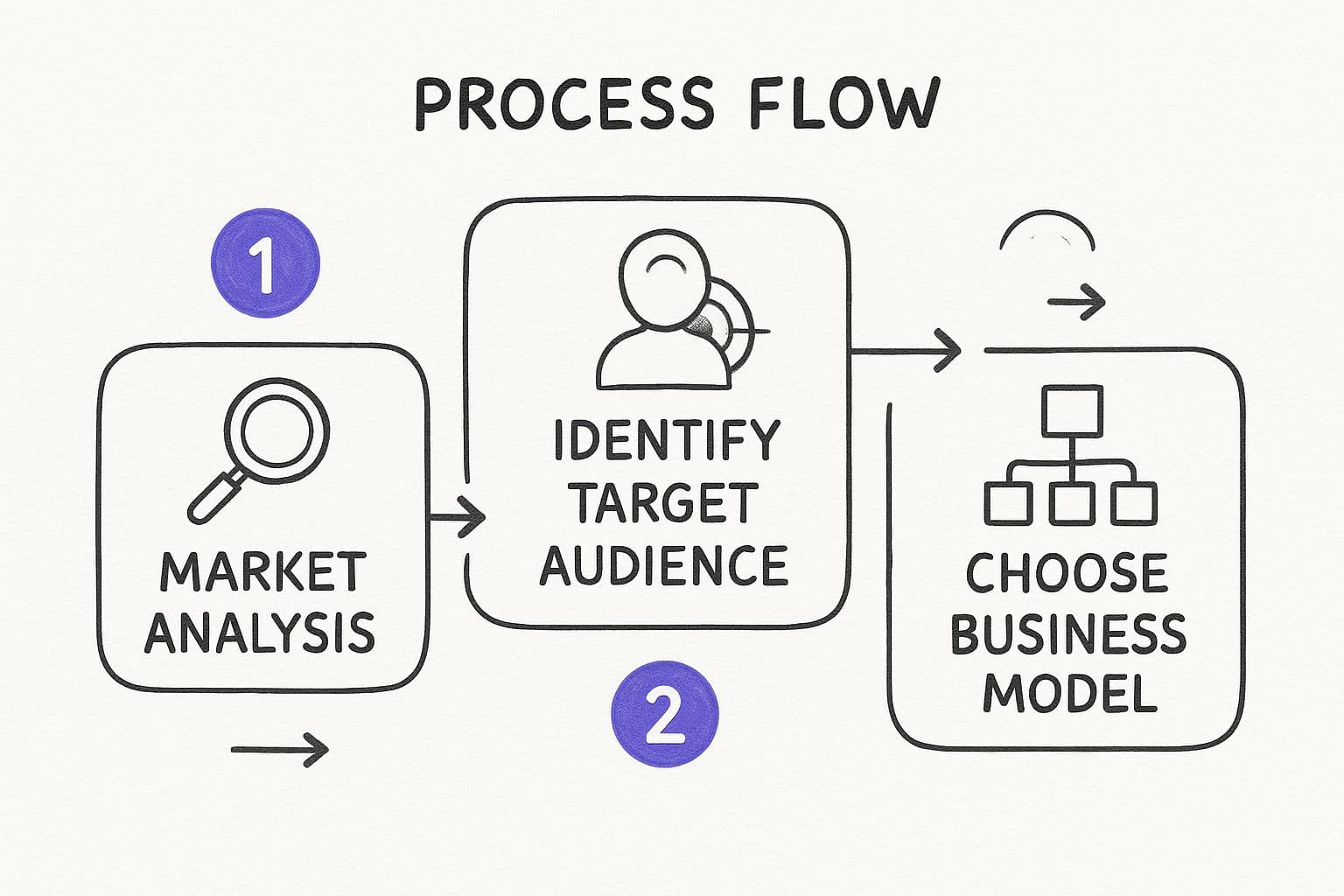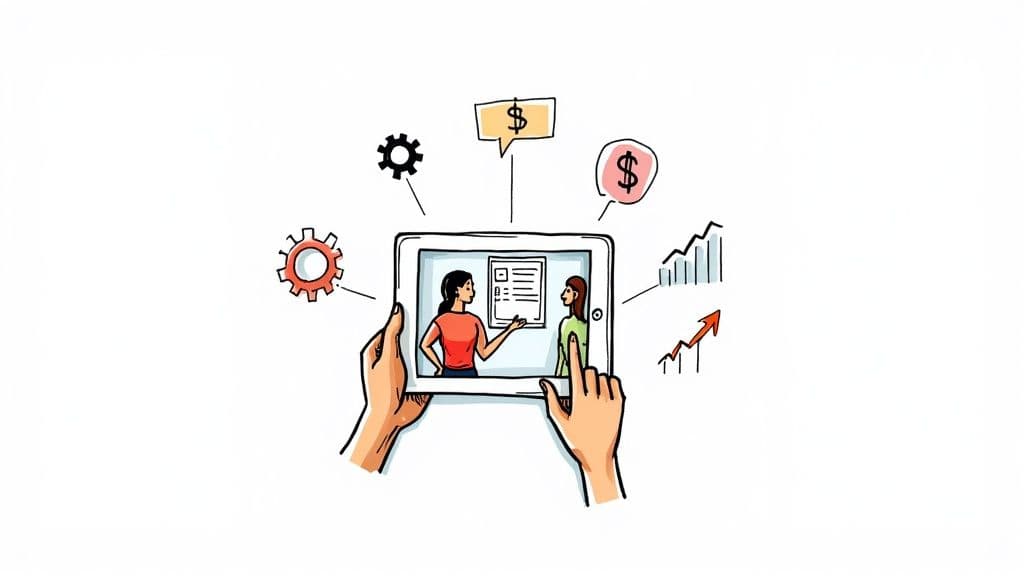Thinking about turning your passion for fitness into a proper business? You're in the right place, and your timing couldn't be better. The demand for online fitness is booming, creating a massive opportunity for new ventures. But this isn't just about posting workout videos; it's about building a sustainable business with a clear strategy from day one.
A solid foundation is everything. A crucial part of this is the need to build your personal branding online, which boosts your digital identity and builds trust from the get-go. This brand becomes the face of your business, attracting the right clients who connect with your unique message and approach.
Charting Your Course
Before you even think about designing a logo or building a website, there are three core decisions you need to nail down. These choices are all connected, and each one will shape the next, dictating the entire structure of your business.

decb726a-a3c3-432b-9a01-05648ec29d62.jpg
This simple flow shows how digging into the market helps you find your specific audience, which in turn makes it much easier to choose the right business model. This structured approach means you’re building your business on real market needs, not just guesswork.
Get these three pillars right, and you're setting yourself up for success:
- Define Your Niche: Who, specifically, do you want to help? New mums getting back into fitness? Busy professionals who need 30-minute workouts? Or maybe older adults focused on improving their mobility? The more specific you are, the easier it is to stand out from the crowd.
- Select Your Business Model: How will you make money? Will you offer high-touch one-on-one coaching, run live group classes, or create a subscription library of pre-recorded content? Each model has very different demands on your time and resources.
- Choose Your Core Technology: A streamlined system is a lifesaver. You don't want to be drowning in admin. Platforms like MyMembers can centralise everything from client onboarding to payment collection, freeing you up to do what you do best—coach.
The secret to a successful launch isn't trying to do everything at once. It’s about making these key decisions correctly from the start. They will form the resilient backbone of your business, paving the way for long-term, sustainable growth.
Before we dive deeper, let's summarise the foundational choices you'll need to make. Getting clarity on these points now will save you countless headaches down the road.
Key Decisions for Your Online Fitness Business Launch
| Decision Area | Key Considerations | Example Choice |
|---|---|---|
| Niche | Who is my ideal client? What specific problem do they have that I can solve better than anyone else? | Busy professionals aged 30-45 who want to lose weight with minimal equipment at home. |
| Business Model | How much time can I commit? Do I prefer one-on-one interaction or a one-to-many approach? What is my income goal? | A tiered subscription model: £20/month for pre-recorded workouts, £75/month for group coaching. |
| Technology | What platform will handle payments, member access, and content delivery smoothly? How can I automate admin tasks? | Using MyMembers to manage subscriptions and automatically grant access to a private Telegram channel. |
Nailing these decisions provides a clear roadmap for your launch and ensures that every part of your business works together seamlessly.
Tapping Into a Growing Market
The hunger for fitness expertise isn't just a fleeting trend; it's a massive market shift. The UK fitness industry has shown incredibly strong growth, particularly since the pandemic reshaped how people approach their health.
In the year leading up to March 2025, UK gyms attracted over 600,000 new members. The overall market penetration among adults hit an all-time high of 16.6%. This isn't just a dry statistic; it's proof of an expanding customer base actively looking for fitness solutions just like yours.
Finding Your Niche in a Crowded Digital Gym

97446800-7dc6-4f7a-9287-1f77dc6dbee7.jpg
Starting an online fitness business without a niche is like shouting into a packed stadium. Nobody hears you.
Success isn't about getting everyone to like you. It’s about becoming the only logical choice for a very specific group of people.
People will tell you to "find your passion," but passion doesn't pay the bills. The real sweet spot is where your passion, your actual skills, and a real audience need all crash together. That’s where you build a brand that can’t be ignored.
Identifying Underserved Audiences
Stop thinking in broad terms like "weight loss" or "yoga." That's a losing game. Instead, think about the people behind the goals. What are their lives actually like? What keeps them up at night?
This simple shift is how you find goldmines that the big, generic brands completely miss.
Instead of broad, think specific. Like:
- Desk workers with chronic back pain who need short, effective mobility routines they can actually do on a lunch break.
- New mums trying to rebuild core strength post-natally, who need safe, guided exercises that fit around a baby’s chaotic schedule.
- Men over 50 who want functional strength to carry groceries and play with their grandkids, not to compete in bodybuilding shows.
- Endurance athletes like runners and cyclists who desperately need cross-training plans to stop getting injured without just piling on more "junk miles."
Each of these groups has its own language, its own problems, and its own goals. Your job is to become fluent in their world.
The magic happens when you stop selling "fitness" and start selling a solution. You're not just a trainer; you're the person who helps new mums feel strong again or the expert who gets office workers out of pain.
Researching and Validating Your Idea
Got an idea for a niche? Good. Now it's time to play detective.
You need to prove that people will actually pay for what you're thinking of offering. Don't skip this. Seriously. This is the step that saves you from building a business nobody wants.
Go where your target audience already lives online. Lurk. Listen. Take notes.
- Facebook Groups: Search for groups like "UK Running Mums" or "Over 40s Fitness UK." What questions pop up over and over? What are their biggest complaints?
- Reddit Subreddits: Places like r/bodyweightfitness or r/xxfitness are full of brutally honest conversations. Search for keywords related to your niche. What are they struggling with?
- Online Forums: Niche-specific forums, like Mumsnet for parents, offer unfiltered insights into the daily grind of your target audience.
You're listening for pain points. Does someone constantly complain they have no time? Are they confused by conflicting advice online? These are the problems you can solve. This groundwork is crucial, a concept that's just as vital if you're exploring how to start an online coaching business of any type.
Crafting Your Unique Selling Proposition
All that research boils down to one thing: your Unique Selling Proposition (USP).
This is just a clear, punchy sentence explaining what you do, who you do it for, and why you’re different. A strong USP acts like a magnet for your ideal client.
It has to answer three questions:
- Who are you helping? (Your Niche)
- What problem are you solving? (Their Pain Point)
- How are you doing it differently? (Your Method)
Let’s make this real. Imagine you're a trainer who loves high-intensity interval training (HIIT).
- Generic Approach: "I'm a personal trainer offering HIIT workouts." (Boring. Instantly forgotten.)
- Niche-Driven USP: "I help busy London professionals get fit in under 30 minutes with equipment-free HIIT workouts they can do from their living room, so they can boost their energy without sacrificing their careers." (Specific. Compelling. Unforgettable.)
See the difference? The second one instantly attracts the right person and repels the wrong one. That single sentence makes all your marketing 10x easier from this day forward.
Building Your Digital Studio and Crafting Irresistible Offers

27248d31-7450-47a5-8a48-659b82451b7e.jpg
Alright, you’ve nailed your niche. Now for the fun part: building the space where your business will actually live and breathe. This is your digital studio—the mash-up of platforms, tech, and tools you'll use to deliver your brand of fitness to clients.
This is also where you package your expertise into offers so compelling that your ideal client can’t say no.
Getting this right is about more than just picking the shiniest tech. It’s about creating a seamless, professional client journey from the moment they sign up to the second they crush their first workout with you. You can't have them getting lost in a mess of different links, logins, and payment fiascos.
Choosing Your Online Platform
Your platform is the foundation of the entire client experience. When you first start an online fitness business, the options can feel pretty overwhelming, from super-simple social media setups to all-in-one systems that do everything but the burpees for you.
A lot of new trainers start with what they already know:
- Social Media & Messaging Apps: Using private Instagram groups, Facebook groups, or even a Telegram channel can be a fast, low-cost way to get the ball rolling. You can drop workouts, build a bit of community, and chat directly with clients. The downside? It’s all manual, and it gets chaotic fast as you grow.
- A Dedicated Website: Building a website with a tool like Wix or Squarespace gives you a professional home base that you actually own. It’s where you can show off your services, share testimonials, and write a blog to pull in new clients from search engines. It adds instant credibility.
But here’s the problem with just having a website: you still have to manage members, chase payments, and control who sees what content. That admin work is a killer. This is where dedicated membership tools become your best friend.
The goal isn't to find the 'best' platform, but the right platform for your specific business model and your clients. The less time you spend on admin, the more time you have for coaching.
Streamlining Operations with Integrated Systems
Picture this: a new client signs up, pays, and is instantly added to your private coaching group and workout library. You didn’t lift a finger. That's the magic of an integrated system.
Platforms like MyMembers are built for exactly this. They act as the central hub for your business, connecting your payment processor (like Stripe) with your communication tool (like Telegram) to automate the entire client journey.
Here’s how that plays out:
- A client lands on your custom sign-up page.
- They pick a membership plan (e.g., a monthly subscription or a one-off programme).
- They pay securely through Stripe.
- MyMembers automatically zaps them an invite to your private Telegram channel.
- If their subscription ends, it automatically removes them. No awkward "your payment failed" conversations.
This level of automation is a complete game-changer. It gets rid of manual invoicing, chasing payments, and managing messy spreadsheets. It creates a smooth experience that builds client trust and frees you up to focus on what you’re actually good at: getting people results.
Designing Your Service and Product Offers
With your digital studio's foundation in place, you can now start structuring your offers. How are you going to package up your expertise? Your offers need to hit the pain points of your niche head-on and provide a clear path to their goals.
When you're setting up your studio, choosing the right video training software solutions is a big deal. High-quality video and sound make your offers feel more premium and show you’re a pro who takes this seriously.
A tiered approach is a great way to cater to different budgets and commitment levels:
- Low-Tier Offer (e.g., £15-£30/month): A subscription to a library of pre-recorded workouts. This is a high-volume, low-touch model that can generate some nice passive income.
- Mid-Tier Offer (e.g., £50-£100/month): Group coaching programmes. These usually mix in live virtual classes, a community group, and a bit more direct support from you.
- High-Tier Offer (e.g., £150+/month): One-on-one personal coaching. This is your premium service with personalised programming, nutrition guidance, and direct access to you.
This mix means you can help more people and create an 'ascension ladder' where happy clients can easily upgrade as they see more value and get better results.
The online coaching world in the UK is booming. The market is set to grow at a compound annual growth rate of 29.8% between 2025 and 2030. In 2024, live group virtual sessions were the most popular format, making up around 58.86% of revenue, which tells you people are hungry for interactive, community-focused experiences. You can dig into the numbers in this virtual fitness market analysis.
Creating High-Value Content That Attracts and Converts
Your digital studio is up, and your offers are dialled in. So, what now? You need to get the right people through the virtual door. This is where your content strategy becomes your single most powerful tool.
I’m not talking about posting random workout clips and hoping for the best. We’re building a calculated plan to create content that cements your authority, nurtures a real community, and naturally guides followers toward becoming paying clients. Think of your content as your storefront, your sales team, and your proof of expertise all rolled into one. It’s how you show your value long before you ever ask for a sale.
More Than Just Workout Videos
One of the biggest mistakes I see new online fitness coaches make is thinking their content should just be exercise demonstrations. While those are useful, they're only one tiny piece of a much larger puzzle. An effective strategy is a smart mix of different content formats, each doing a specific job.
You need to educate, entertain, and inspire. It’s this holistic approach that builds a proper connection with your audience on multiple levels.
Here’s what a solid, well-rounded content mix actually looks like:
- Educational Blog Posts: Think like your ideal client. What are they typing into Google? Create SEO-optimised articles that answer their burning questions. Stuff like, "5 Common Mistakes Runners Make When Strength Training" or "A Beginner's Guide to Post-Natal Core Recovery." This is how you become a trusted authority.
- Short-Form Video (Reels & TikToks): This is where you let your personality shine. Use these for quick-fire tips, busting common fitness myths, sharing behind-the-scenes glimpses of your own training, or celebrating client wins. It’s your chance to be relatable and build a human connection.
- Valuable Lead Magnets: These are the engines of your email list. You offer a free, high-value resource in exchange for an email address. A free 7-day workout plan, a recipe e-book, or a mobility guide are all perfect examples.
This multi-format approach means you’re meeting your audience wherever they are, whether they’re searching for in-depth answers or just scrolling for a quick hit of motivation.
Planning Your Content for Consistency
Trust is built on consistency. Sporadic posting just won’t cut it. But the secret isn't to create more content; it's to plan smarter. This is where a content calendar becomes your best friend.
A content calendar is just a simple schedule that maps out what you'll post, where you'll post it, and when. It kills the daily stress of "what the hell do I post today?" and helps you create cohesive, themed content that actually supports your business goals.
For instance, you could theme your content by the week:
- Week 1: Focus on a foundational concept (e.g., the importance of protein).
- Week 2: Share practical applications (e.g., high-protein meal prep ideas).
- Week 3: Tackle common challenges (e.g., "I'm vegetarian, how do I get enough protein?").
- Week 4: Promote a related offer (e.g., your nutrition coaching programme).
Suddenly, content creation feels manageable and way more effective.
The Art of the Soft Sell
Aggressive, hard-selling tactics will kill the community you're working so hard to build. Fast. Your content should do the heavy lifting for you, warming up your audience so that when you do make an offer, it feels like the natural, obvious next step. This is the 'soft sell'.
You pull this off by consistently giving away immense value for free. You solve small problems with your blog posts, inspire action with your videos, and offer a real taste of your expertise with your lead magnets. After a follower has been consuming your content for a few weeks, they should already trust your methods and get your entire approach.
When your free content is better than someone else's paid content, your audience will naturally wonder what amazing value lies behind your paywall. You establish so much trust upfront that the decision to sign up becomes an easy and logical one for them.
This strategy turns your content from a simple marketing tool into an automated sales process. It’s a fundamental concept, and learning how to package and present this value is everything. The principle applies way beyond fitness; for instance, you'll find similar ideas if you're learning how to sell online courses effectively, where value-driven content is absolutely essential.
Ultimately, your content strategy is about playing the long game. It’s about building a brand that people trust and a community that feels genuinely looked after. When you focus on giving value and solving problems first, the conversions will follow. I promise.
Grow Your Tribe and Scale Your Fitness Business

72d1b539-9040-40ea-9267-36c429c183d5.jpg
Getting your online fitness business live is a huge win, but let’s be real—it’s just the starting line. Lasting success comes down to two things: smart marketing to get your first clients, and a solid plan to grow without burning out.
Without both, even the best programme will struggle to find an audience. This is where you switch hats from a coach to a business owner. Your first mission? Get those initial paying clients through the door to build momentum and bring in that all-important early cash.
Landing Your First Clients
Getting your first clients is all about trust and proving your worth. Forget about complicated marketing funnels for now. Your focus should be on direct, authentic outreach and making real connections.
- Social Media Marketing: Don't just post workouts. Use platforms like Instagram and Facebook to tell your story. Share client transformations (with their permission, of course!), drop educational tips that solve problems for your niche, and run live Q&A sessions. Jump into the comments and actually talk to people.
- Email Marketing: Your email list is gold. You own it. From day one, use those lead magnets we talked about to collect email addresses. Send out a weekly newsletter with exclusive tips, behind-the-scenes content, and genuine insights.
- Targeted Paid Ads: Once you’ve got some money coming in, think about a small budget for Facebook or Instagram ads. You can target people with scary precision based on their age, location, and interests. Even a modest £10-£20 a day can send a stream of ideal clients straight to your sign-up page.
Building a Community People Won't Leave
Getting a new customer costs five times more than keeping an existing one. That’s why your focus has to shift from just getting new clients to keeping the ones you have happy. Happy clients don't just stay; they become your best salespeople.
A strong community turns a simple transaction into a real sense of belonging. Your clients aren't just buying workouts; they're joining a tribe. This is your moat against competitors.
Never underestimate the power of community. When clients feel connected to you and each other, they are far more likely to stick around long-term. Their membership becomes part of their identity.
To get this right, you have to actively gather feedback, celebrate their wins, and encourage banter in your private groups. Making people feel seen is the secret sauce.
Smart Strategies for Long-Term Growth
Thinking about scaling isn't getting ahead of yourself; it’s about future-proofing your business. Relying only on one-on-one coaching will lead to burnout. You can’t create more hours in the day. To grow, you have to find ways to separate your income from your time.
The UK fitness market is packed. As of 2022, the number of trainers hit 69,300, a 76% jump in just over a decade. But with that growth comes fierce competition, and staying in business is a real fight—less than half of new fitness businesses survive past five years. This makes it absolutely essential to have more than one way to make money.
Here’s how you can start scaling properly:
- Introduce New Revenue Streams: Look at your current clients. What else do they need? You could run specialised workshops (e.g., "Mastering the Kettlebell Swing"), sell branded merch, or team up with a nutritionist for joint packages.
- Create Digital Products: Package your knowledge into a one-time purchase. This could be a detailed e-book, a standalone 4-week programme, or a series of pre-recorded video masterclasses. These make money while you sleep.
- Hire Other Coaches: As your brand gets bigger, you could bring on other certified coaches who share your philosophy. This lets you serve more clients under your brand without you having to do all the work.
These scaling tactics are crucial for building a resilient and profitable business. For a deeper dive into expanding your client base, our guide on proven membership growth strategies has more tactics you can use straight away. By mixing smart marketing with a clear vision for growth, you can turn your passion into a career that actually lasts.
Got Questions? Let's Talk Brass Tacks
Jumping into an online fitness business is exciting, but let's be real—you've probably got a dozen questions buzzing around your head. I've been there. Below, I’ve broken down the most common queries I hear, with straight-talking answers to help you navigate the big decisions and legal stuff here in the UK.
How Much Coin Do I Actually Need to Start an Online Fitness Business in the UK?
Honestly, this can swing wildly depending on how you play it. You could absolutely bootstrap this and get a lean version off the ground for under £200. We're talking using your existing social media for coaching, free apps like WhatsApp for comms, and whatever free software you can get your hands on.
But if you're serious about building a proper, scalable brand? You'll need to invest a bit more. A realistic launch budget sits somewhere between £500 and £2,500.
What does that money actually get you?
- Platform Subs: A small fee for a membership tool like MyMembers to automate your life.
- Pro Insurance: This is non-negotiable. Don't even think about skipping it.
- Website & Domain: Your digital storefront. Makes you look legit.
- Decent Kit: A good camera, microphone, and some lighting. Grainy, poorly lit videos just don't cut it anymore.
- Ad Spend: A little pot of cash to run some targeted ads and reel in those first few clients.
The beauty of going online is the massively lower overhead. No rent, no eye-watering equipment leases. It's the most accessible way to get into the fitness game, period.
What Legal Bits and Insurance Do I Need to Sort Out?
Operating above board isn't just a good idea—it's essential for your credibility and, frankly, to protect you from disaster. In the UK, there are a few key things you must get sorted before you even think about training your first client.
First, you’ve got to register your business. You can fly as a sole trader (the simplest setup) or go for a limited company through HMRC. They have different tax and liability rules, so do a bit of digging to see which fits your long-term plan.
Insurance is the big one. You absolutely must have:
- Public Liability Insurance: This covers you if someone claims you caused an injury or damaged their property.
- Professional Indemnity Insurance: This protects you if a client gets hurt and blames your advice or programming.
Seriously, don't skip this. Training clients without the right insurance is a catastrophic risk that could wipe you out financially. My advice? Talk to an insurance broker who specialises in the fitness industry. It's a smart move.
Also, if you're collecting any client info (names, emails, health data), you're legally on the hook to comply with GDPR. And as standard practice, get every client to sign a liability waiver and fill out a Physical Activity Readiness Questionnaire (PAR-Q) before they do a single squat.
How Do I Figure Out What to Charge for My Online Fitness Services?
Pricing is part art, part science. The biggest mistake I see new coaches make is just peeking at what everyone else is charging and copying it. Bad move. Your pricing should reflect the transformation you deliver for your specific niche.
For 1-on-1 coaching, your rates are a direct reflection of your time and hands-on expertise. In the UK, this could be anywhere from £40 to over £150 an hour, depending on your reputation and how deep your service goes.
For group programmes or subscriptions, you can charge less per head but play a volume game. A monthly sub for a workout library and community access typically lands between £15 and £50.
A great way to approach this is with tiered packages. It gives people different ways to buy into your world. For example:
- Basic Tier: Access to your library of pre-recorded workouts.
- Mid-Tier: All of the above, plus live group classes and community access.
- Premium Tier: The whole lot, plus regular one-on-one check-ins.
This creates multiple doors into your business, catering to different budgets and commitment levels.
Can I Start an Online Fitness Business Without Any Certifications?
Technically, there’s no law stopping you. But doing so is professionally irresponsible and, frankly, a terrible idea. A sustainable business is built on trust and expertise, not guesswork.
A proper UK qualification, like a Level 3 Diploma in Personal Training, gives you the foundational knowledge of anatomy, physiology, and safe programming. This isn't just fluff; it's what stops you from injuring your clients.
But here’s the real kicker: you’ll find it almost impossible to get professional indemnity insurance without a recognised qualification. That leaves you totally exposed if a client gets hurt following your advice. Certifications aren't just a piece of paper—they are your proof of competence, a key to getting insured, and the bedrock of your credibility.
Ready to turn your Telegram community into a thriving fitness business? MyMembers automates your payments and member management, so you can focus on what you do best—coaching. Create your custom landing page and start accepting payments in minutes. Build your fitness empire with MyMembers today.
